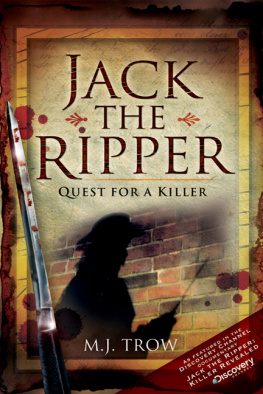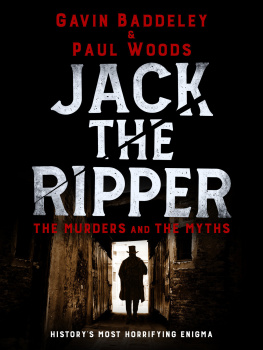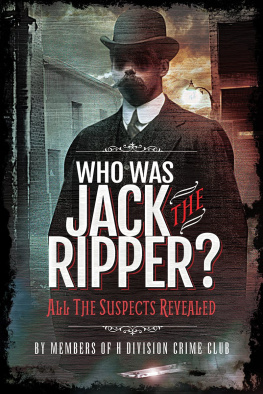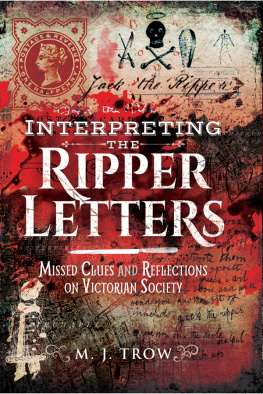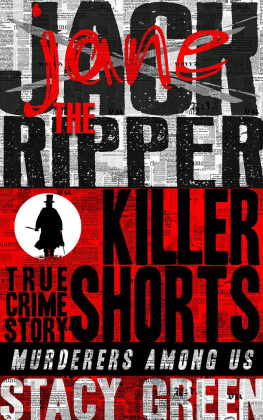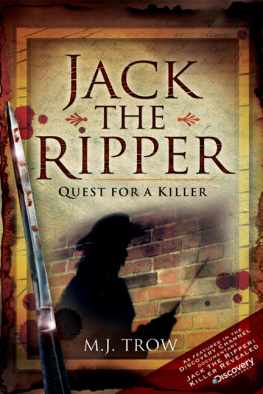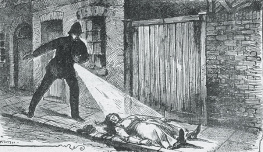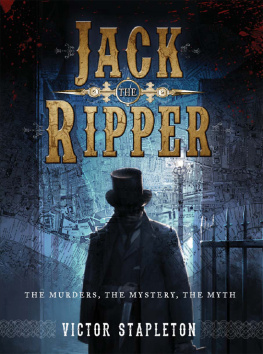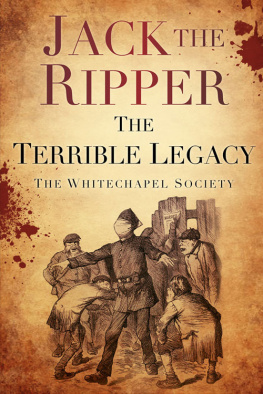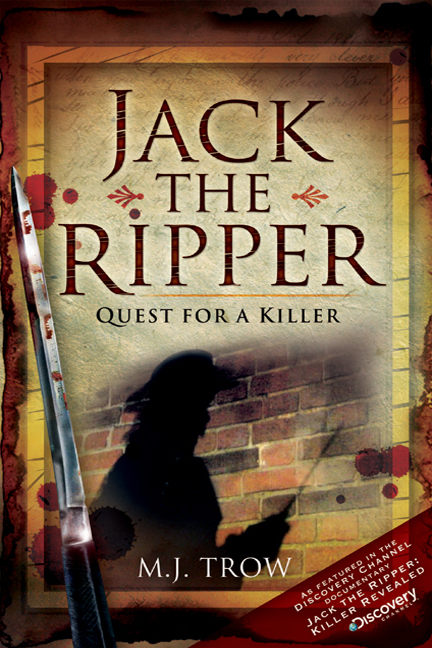My thanks for help in writing this book must go first and foremost to my wife, Carol, whose photographs, copy-editing and all-round enthusiasm are, as always, invaluable. To Rupert Harding and his team at Pen and Sword, for meeting impossible deadlines. To Elliot McCaffrey and his team at Atlantic Productions for their faith in me. To Professor Laurence Alison, Director of the Centre for Critical and Major Incident Research, University of Liverpool; Spencer Chainey of the Jill Dando Institute, University College London; Alan Humphries, Librarian of the Thackray Museum, Leeds and Dr Peter Dean, Coroner for Suffolk and South East Essex, for their professionalism and insight; and to Ripper expert John Bennett for his profound knowledge of Jacks killing fields.
Chapter 1
The Problem: The House That Jack Built
The bare facts are these. In the Autumn of 1888 a disputed number of women, all of them prostitutes, were murdered in the East End of London, by person or persons unknown. Because the killer was never caught, in itself the result of extraordinary luck on his part and ineptitude on the part of the police force of the time, a whole industry has grown up around the case, taking us further and further away from the truth.
The myth of the man who was Jack the Ripper began on 24 September 1888 when an anonymous letter was sent to Sir Charles Warren, Commissioner of the Metropolitan Police at Scotland Yard. Intriguingly, bearing in mind what we now know about the psychology of serial killers, its opening sentence is darkly real I do wish to give myself up I am in misery with nightmare
It smacks of another serial offender, William Heirens, who, having stabbed and shot Frances Brown in Chicago in December 1945 scrawled with her lipstick on the wall above her body, For heavens sake catch me before I kill more. I cannot control myself.
But in fact, the letter to Charles Warren was a hoax, as were nearly all the other 220 letters and postcards sent to the police and the Press in the months surrounding the Whitechapel murders.
It was the second letter, sent to the Central News Agency in New Bridge Street three days later that captured the publics imagination and launched the phenomenon that shows no sign of abating today. Dear Boss, it began, and gloated over the grand job, the funny little games and apologized for having to write in red ink because the proper red stuff had congealed. It gave a deadly motive for the crimes I am down on whores but most importantly, it gave the trade name, Yours truly, Jack the Ripper.
Today, informed opinion follows senior police officers views at the time that this was a piece of journalistic mischief, posted to his own office by Thomas J Bulling of the Central News Agency. If this is so, then the Dear Boss was a very in joke, because the editor-in-chief who would have received it was John Moore, quite possibly in on the whole thing. Another possibility is that the author was John Best, a freelance who wrote for the Star , working with the connivance of its editor, T P OConnor. In a sense, it does not matter who wrote the Dear Boss letter. What is important is that as soon as it was published, a rash of copy-cats followed and the infamous name stuck for ever. Right through to October 1896, missives in all sorts of handwriting and styles created the kernel of the myth.
One came from George of the High Rip Gang, one of the dozens of armed and dangerous low-life who terrorized the East End. Another was written by Jack the Cunquerer [sic]; a third by Yours when caught, the Whore Killer. They were not confined to London postmarks, proving how quickly the Ripper phenomenon became national and eventually international. One Jack was hiding in a quarry in Plymouth on 10 October 1888. Another one was enjoying a holiday in Leicester on the same day. Mr Englishman, rather annoyed that his work had been hijacked by the Ripper, wrote indignantly to complain from Colchester. JR was busy by the middle of the month at the Leylands in Leeds and HTB, though writing from Portsmouth, threatened not only to murder several rich women in Clerkenwell, but Lady Warren, wife of the Police Commissioner.
A Frenchman, giving himself the gloriously exotic name Isidore Vasyvair wrote to Monsieur le Chef de la Police early in October, and on the same day the Ripper wrote from Dublin, but claimed to live in Calcutta. In an obvious pastiche of Bulling/Best, Jack, o estripador wrote from Lisbon on 24 October. A scholarly letter from Philadelphia arrived later that month, taunting the Scotland Yard boys and promising, once the writer has the lay of the locality to rip and cull between twenty and forty more victims.
The hoaxers who began the Ripper industry throw a spotlight on the bizarre mindset of 1888. To my knowledge, no one has analyzed these letters in terms of psychology. Most of them exhibit gallows humour with bad drawings of knives, skulls, guns, coffins and dripping blood. They abound with ha has and endless criticism of the police, for being unable to catch them. Some are barely literate Dear Sir, I drop a line to say hav sniped enother and send so Ill do me job furst he gon on catle bote or with muckers Yours truly JR. Rite gain in a weak. Some are highly literate I am writing to you this while in bed with a sore throat, but as soon as it is better I will set to work again this one purported to be a policeman. One was in verse form:

